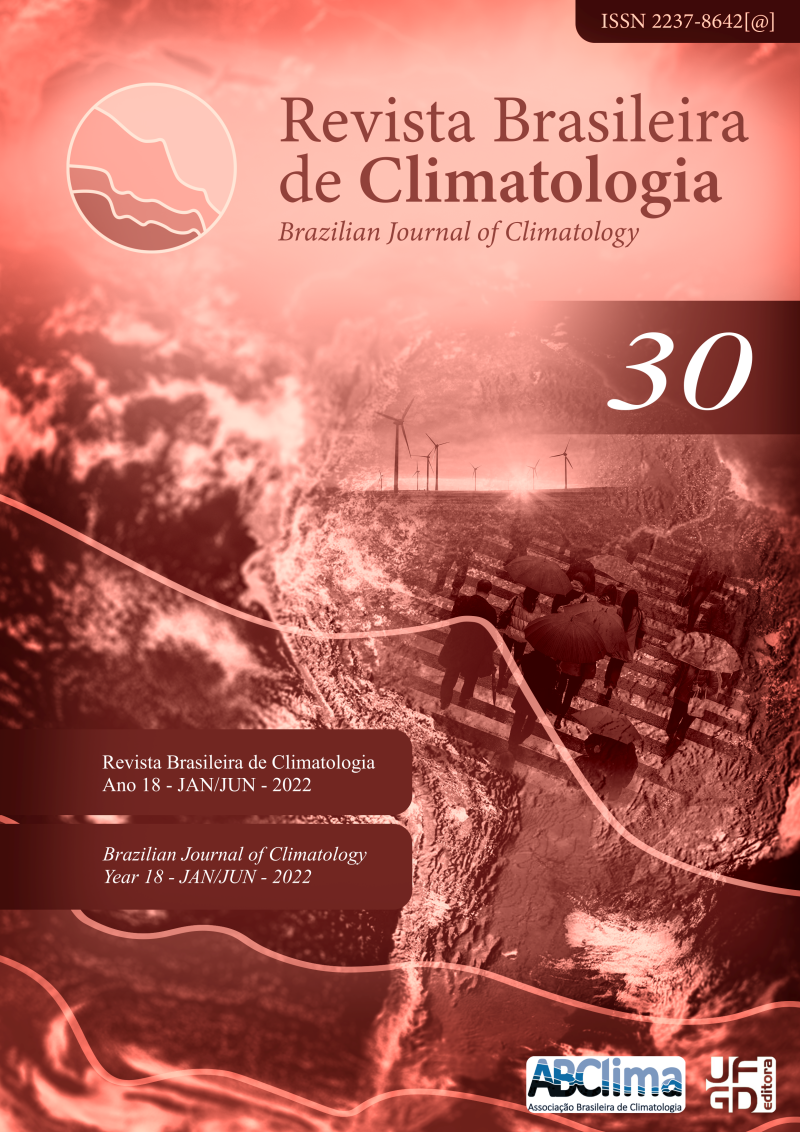Characterization of the wind vertical profile in Iperó (São Paulo) with the use of a doppler lidar
DOI:
https://doi.org/10.55761/abclima.v30i18.15582Keywords:
lidar Doppler, capa limite planetaria, perfil vertical del vientoAbstract
A Doppler lidar with a range up to 290 m operated continuously for 1 year in the municipality of Iperó, São Paulo State. This lidar has high vertical and temporal resolution and estimates beyond the speed and direction of the horizontal wind as well as the vertical speed of the wind. The database generated during this experimental campaign will allow the study the of Planetary Boundary Layer phenomena, as well as to validate numerical models and to assist studies of transport and dispersion of pollutants. This work presents the characterization of the vertical wind profile and the annual cycle between August/2017 and July/2018.
Downloads
References
BEU, Cássia Maria Leme. Estudo do jato de baixos níveis em Iperó com a técnica lidar Doppler. 2019. Tese (Doutorado em Ciências). Universidade de São Paulo, São Paulo, 2019.
BODINI, Nicola. et al. Spatial and temporal variability of turbulence dissipation rate in complex terrain. Atmospheric Chemistry and Physics Discussions, [s. l.], v. 19, n. 7, p. 4367-4382– 4382, Apr. 2019. DOI: https://doi.org/10.5194/acp-19-4367-2019
BODINI, Nicola; LUNDQUIST, Julie; NEWSOM, Rob. Estimation of turbulence dissipation rate and its variability from sonic anemometer and wind Doppler lidar during the XPIA field campaign. Atmospheric Meas. Tech., [s. l.], v. 11, n. 7, p. 4291– 4302, Jul. 2018. DOI: https://doi.org/10.5194/amt-11-4291-2018
BONIN, Timothy et al. Improvement of vertical velocity statistics measured by a Doppler lidar through comparison with sonic anemometer observations. Atmospheric Meas. Tech., [s. l.], v. 9, n. 12, p. 5833–5852, Dec. 2016. DOI: https://doi.org/10.5194/amt-9-5833-2016
INSTITUTO DE ASTRONOMIA, GEOFÍSICA E CIÊNCIAS ATMOSFÉRICAS. Grupo de Micrometeorologia. Ipero Project, São Paulo: IAG-USP, 2004. Disponível em: http://www.labmicro.iag.usp.br/projetos/Ipero/index.html. Acesso em: 23 jun. 2020.
KARAM, Hugo Abi. Estudo do jato de baixos níveis de Iperó e das implicações no transporte de poluentes no Estado de São Paulo. 2002. Tese (Doutorado em Ciências). Universidade de São Paulo, São Paulo, 2002.
MARKOWSKI, Paul; RICHARDSON, Yvette. Mesoscale meteorology in midlatitudes. John Wiley & Sons, 2011. DOI: https://doi.org/10.1002/9780470682104
NATIONAL RENEWABLE ENERGY LABORATORY; CLIFTON, Andrew. Remote Sensing of Complex Flows by Doppler Wind Lidar : Issues and Preliminary Recommendations. Golden: NREL, 2015.
NEWMAN, Jennifer; CLIFTON, Andrew. An error reduction algorithm to improve lidar turbulence estimates for wind energy. Wind Energ. Sci., [s. l.], v. 2, n. 1, p. 77–95, Feb. 2017. DOI: https://doi.org/10.5194/wes-2-77-2017
STULL, Rolland. An introduction to boundary meteorology. Springer Science & Business Media, 1988. DOI: https://doi.org/10.1007/978-94-009-3027-8
TOMLINSON, Charlie et al. Remote sensing land surface temperature for meteorology and climatology: A review. Meteorol. Appl., [s. l.], v. 18, n. 3, p. 296–306, 2011. DOI: https://doi.org/10.1002/met.287
WEITKAMP, Claus (Ed.). Lidar: range-resolved optical remote sensing of the atmosphere. Springer Science & Business, 2006.
Downloads
Published
How to Cite
Issue
Section
License
A aprovação dos artigos implica a aceitação imediata e sem ônus de que a Revista Brasileira de Climatologia terá exclusividade na primeira publicação do artigo. Os autores continuarão, não obstante, a deter os direitos autorais. Os autores autorizam também que seus artigos sejam disponibilizados em todos os indexadores aos quais a revista está vinculada.
Os autores mantém seus direitos de publicação sem restrições
A Comissão Editorial não se responsabiliza pelos conceitos ou afirmações expressos nos trabalhos publicados, que são de inteira responsabilidade dos autores.
A Revista Brasileira de Climatologia oferece acesso livre imediato ao seu conteúdo, seguindo o entendimento de que disponibilizar gratuitamente o conhecimento científico ao público proporciona maior democratização do conhecimento e tende a produzir maior impacto dos artigos publicados. Os artigos publicados na revista são disponibilizados segundo a Licença Creative Commons CC-BY-NC 4.0 (https://creativecommons.org/licenses/by-nc/4.0/). Segundo essa licença é permitido acessar, distribuir e reutilizar os artigos para fins não comerciais desde que citados os autores e a fonte. Ao submeter artigos à Revista Brasileira de Climatologia, os autores concordam em tornar seus textos legalmente disponíveis segundo essa licença




